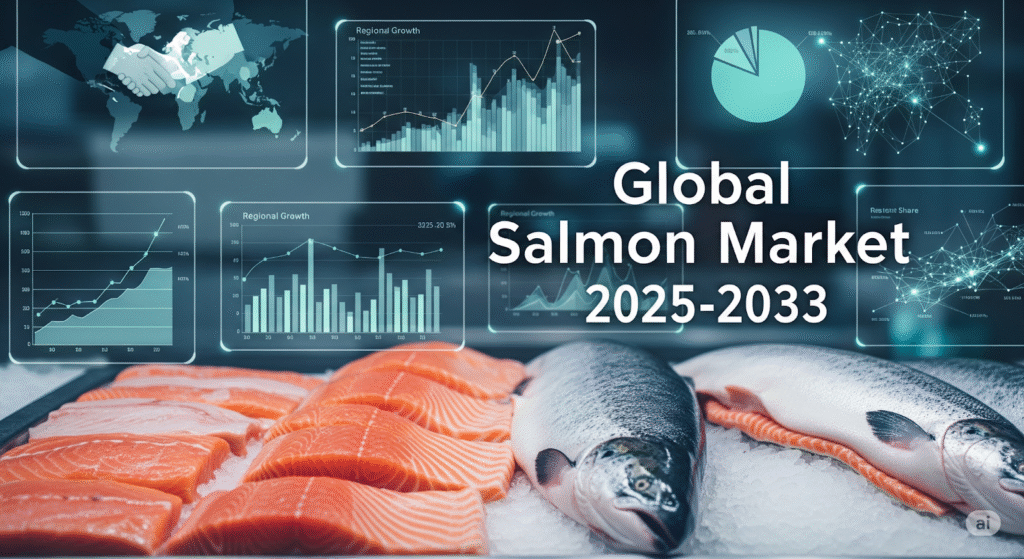
The global Salmon Market is experiencing robust growth, driven by increasing health consciousness, rising disposable incomes, and a growing preference for nutritious seafood options. In 2024, the market reached a volume of 3.7 million tons, and it is projected to attain 4.8 million tons by 2033, expanding at a CAGR of 3.0% during 2025-2033. Key factors propelling this growth include advancements in aquaculture technologies, favourable government policies supporting sustainable fisheries, and the escalating demand for value-added salmon products. Notably, the European Union currently dominates global consumption, accounting for over 46.3% of the market share in 2024.
STUDY ASSUMPTION YEARS
- Base Year: 2024
- Historical Years: 2019-2024
- Forecast Years: 2025-2033
SALMON MARKET KEY TAKEAWAYS
- Market Size and Growth: The global salmon market reached 3.7 million tons in 2024 and is expected to grow to 4.8 million tons by 2033, exhibiting a CAGR of 3.0% during 2025-2033.
- Dominant Consumption Region: The European Union leads global consumption, holding over 46.3% market share in 2024.
- Type Segment: Farmed salmon accounts for most of the market share, ensuring year-round availability and predictable supply.
- Species Preference: Atlantic salmon holds the largest share in the salmon industry, attributed to its high protein and omega-3 content.
- Product Form: Frozen salmon remains a dominant segment due to its cost-effectiveness and extended shelf life, appealing to both consumers and businesses.
- Distribution Channel: Foodservice represents the leading distribution channel segment, driven by the increasing demand for ready-to-eat and convenience seafood products.
MARKET GROWTH FACTORS
- Rising Global Seafood Consumption
The growing demand for seafood worldwide is boosting the salmon market. Consumers increasingly prefer healthy protein options like salmon for their nutritional benefits, such as Omega-3 fatty acids, vitamins, and minerals. This trend is fueling demand in retail, restaurants, and processed food applications. Feedstock such as high-quality fish feed, including pellets enriched with proteins and nutrients, supports consistent production. Manufacturers are scaling aquaculture operations to meet rising consumption, while sustainability practices and traceability in feedstock sourcing enhance market confidence. With expanding consumer awareness and rising disposable incomes, the global salmon market is witnessing steady growth, especially in North America, Europe, and the Asia-Pacific.
- Advancements in Aquaculture Technology
Innovative aquaculture techniques, like recirculating aquaculture systems (RAS) and automated feeding, are transforming salmon production. These technologies improve feed efficiency, reduce mortality, and ensure high-quality salmon for retail and processing applications. Feedstock optimization, including enriched pellets and alternative protein sources, supports faster growth and healthier fish. Advanced monitoring systems help maintain water quality, temperature, and oxygen levels, crucial for sustainable production. By lowering production costs and increasing output, these technological improvements are attracting manufacturers and investors. The enhanced efficiency ensures year-round availability, making salmon a reliable ingredient for restaurants, ready-to-eat meals, and processed seafood products globally.
- Rising Popularity of Ready-to-Eat Products
Ready-to-eat salmon meals, sushi, and smoked salmon attract busy consumers and health-conscious buyers. Applications include restaurants, foodservice, and home meal solutions. Feedstock quality, including enriched fish feed, is vital to ensure taste, freshness, and nutritional value. Manufacturers are creating pre-portioned, vacuum-packed, and marinated salmon products for convenience. Urban lifestyles and time constraints drive demand for these products, while retail and online channels provide easy access. Ready-to-eat salmon is also used in gourmet and functional food products, making it a versatile ingredient. This trend is boosting market growth and profitability for producers and processors alike.
Request for a sample copy of this report:
https://www.imarcgroup.com/salmon-market/requestsample
MARKET SEGMENTATION
By Type:
- Farmed: Accounts for most shares due to its ability to meet the growing global demand for salmon at a more consistent and affordable price.
- Wild Captured: Preferred for its natural diet and flavor profile, catering to niche markets and traditional consumption patterns.
By Species:
- Atlantic: Holds the largest share in the salmon industry, attributed to its high protein and omega-3 content.
- Pink: Known for its mild flavour and affordability, making it popular among consumers seeking value options.
- Chum/Dog: Valued for its firm texture and suitability for smoking and canning processes.
- Coho: Appreciated for its rich taste and vibrant colour, often used in premium culinary applications.
- Sockeye: Recognized for its deep red flesh and robust flavour, favoured in gourmet dishes.
- Others: Includes lesser-known species catering to specific regional preferences and culinary uses.
By End Product Type:
- Frozen: Remains a dominant segment due to its cost-effectiveness and extended shelf life, appealing to both consumers and businesses.
- Fresh: Preferred for its taste and texture, often consumed in regions with access to local fisheries.
- Canned: Offers convenience and affordability, widely accepted in North America and Europe.
- Others: Includes smoked, cured, and ready-to-eat products catering to diverse consumer preferences.
By Distribution Channel:
- Foodservice: Represents the leading distribution channel segment, driven by the increasing demand for ready-to-eat and convenience seafood products.
- Retail: Encompasses supermarkets, hypermarkets, and online platforms, offering a wide range of salmon products to consumers.
Breakup by Region:
- North America (United States, Canada)
- Asia Pacific (China, Japan, India, South Korea, Australia, Indonesia, Others)
- Europe (Germany, France, United Kingdom, Italy, Spain, Russia, Others)
- Latin America (Brazil, Mexico, Others)
- Middle East and Africa
REGIONAL INSIGHTS
In 2024, the European Union dominated the global salmon market, accounting for more than 46.3% of total consumption. This robust standing is attributed to the high demand for both farmed and wild salmon across various EU nations. Favorable government regulations and a strong emphasis on sustainable fishing practices have contributed to increasing salmon supply and aligning with the rising consumer desire for healthy, environmentally friendly seafood.
RECENT DEVELOPMENTS & NEWS
Recent improvements in fish farming technology are helping the salmon market grow faster. New methods like recirculating aquaculture systems (RAS) and eco-friendly fish feed are making salmon farming more efficient and better for the environment. At the same time, more people are buying salmon online thanks to subscription services and bulk order discounts. These changes show how the industry is working to meet rising global demand while staying sustainable and accessible.
KEY PLAYERS
Cermaq Group, Lerøy Seafood Group ASA, Mowi ASA, and SalMar ASA, etc.
Ask Analyst for Customization:
https://www.imarcgroup.com/request?type=report&id=974&flag=C
If you require any specific information that is not covered currently within the scope of the report, we will provide the same as a part of the customization.
About Us:
IMARC Group is a global management consulting firm that helps the world’s most ambitious changemakers to create a lasting impact. The company provides a comprehensive suite of market entry and expansion services. IMARC offerings include a thorough market assessment, feasibility studies, company incorporation assistance, factory setup support, regulatory approvals and licensing navigation, branding, marketing and sales strategies, competitive landscape, and benchmarking analyses, pricing and cost research, and procurement research.
Contact Us:
IMARC Group
134 N 4th St. Brooklyn, NY 11249, USA
Email: sales@imarcgroup.com
Tel No:(D) +91 120 433 0800
United States: (+1-201971-6302)

